Meet Quetzalcoatlus – World’s Largest Flying Animal Had A Wingspan Of Up To 52 Feet (15.9 m)
Eddie Gonzales Jr. - AncientPages.com - About 100 to 66 million years ago, during the Late Cretaceous, the climate was warmer than the present. Many new species appeared on all continents, including the giant Quetzalcoatlus that lived in North America.
The Quetzalcoatlus compared to a man, car, and pterodactyl. Source Pinterest
With a wingspan reaching as much as 15.9 m (52 ft), Quetzalcoatlus is one of the largest known flying animals ever. This giant animal was named after the Mesoamerican feathered serpent god, Quetzalcoatl, who was well-known under different names in the region.
The Aztecs called him Quetzalcoatl, and the ancient Maya called him Kukulkan.
The first Quetzalcoatlus fossils were discovered in Texas, the United States, from the Maastrichtian Javelina Formation at Big Bend National Park in 1971 by Douglas A. Lawson. Later, Lawson discovered a second site where he found fragmentary skeletons of much smaller individuals.
It was how we learned about this giant flying animal's existence.
Quetzalcoatlus lived among dinosaurs, but the animal was not a dinosaur. Quetzalcoatlus was the most famous member of the azhdarchids, a family of pterosaurs, a flying reptile.
"The pterosaurs and the dinosaurs appear to have evolved on divergent paths from earlier reptilian life forms. It also seems clear that the pterosaurs did not evolve into the birds.
In this regard, the anatomy is that of the wing. In a pterosaur, the fourth finger of each forelimb was considerably elongated. It supported the front edge of a membrane that stretched from the flank of the body to the farthest tip of the finger. The other fingers were short and reptilian., with a sharp claw at the end of each one.
In a bird, the second finger is the principal strut of the wing, and in the bird, much of the wing consists of course of feathers," Wann Langston explained.
The animal is often depicted with feathers, but researchers think Quetzalcoatlus was covered with pycnofibres, hair-like fibers that differ from animal hair. When Quetzalcoatlus stood on the ground, it was as tall as a giraffe, more than five meters tall (16.4 ft), and weighed 250 kilograms.
Quetzalcoatlus soared the skies, and the animal could see many giant animals walking on our planet. Then, everything ended because about 65 million years ago, about three-quarters of Earth's plant and animal species went extinct.
This event is known as the K-T mass extinction because it occurred at the boundary between the Cretaceous (K) and Tertiary (T) periods. The dinosaurs were the most famous animals to perish, and the Quetzalcoatlus did not survive either.
Updated on October 30, 2024
Written by Eddie Gonzales Jr. - AncientPages.com - MessageToEagle.com Staff Writer
More From Ancient Pages
-
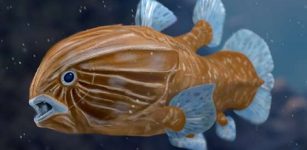 Fossil Study: Coelacanths Thrived In Switzerland After A Mass Extinction
Fossils | Jul 28, 2023
Fossil Study: Coelacanths Thrived In Switzerland After A Mass Extinction
Fossils | Jul 28, 2023 -
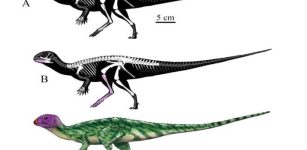 New Species Of Plant-Eating Dinosaur Identified In Thailand
Paleontology | Jul 31, 2023
New Species Of Plant-Eating Dinosaur Identified In Thailand
Paleontology | Jul 31, 2023 -
 Mysterious Ancient Tully Monster Is So Weird It Cannot Be Classified
Fossils | Feb 22, 2017
Mysterious Ancient Tully Monster Is So Weird It Cannot Be Classified
Fossils | Feb 22, 2017 -
 New Species Of Mosasaur Named After Norse Jormungandr Sea Serpent
Paleontology | Oct 31, 2023
New Species Of Mosasaur Named After Norse Jormungandr Sea Serpent
Paleontology | Oct 31, 2023 -
 Fossil Tells The ‘Tail’ Of An Ancient Beast
Paleontology | May 25, 2023
Fossil Tells The ‘Tail’ Of An Ancient Beast
Paleontology | May 25, 2023 -
 Oldest Polar Sea Reptile Fossil Ever Found In Southern Hemisphere
Paleontology | Jun 21, 2024
Oldest Polar Sea Reptile Fossil Ever Found In Southern Hemisphere
Paleontology | Jun 21, 2024 -
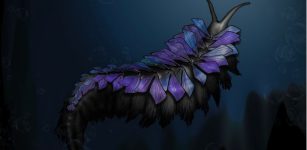 500-Million-Year-Old Sea Worm Named After ‘Dune’ Monster Was Unknown To Science Until Now
Paleontology | Aug 3, 2023
500-Million-Year-Old Sea Worm Named After ‘Dune’ Monster Was Unknown To Science Until Now
Paleontology | Aug 3, 2023 -
 Truth About ‘Welsh Dragons’ Finally Exposed By Scientists
Paleontology | Jun 5, 2024
Truth About ‘Welsh Dragons’ Finally Exposed By Scientists
Paleontology | Jun 5, 2024 -
 Human Ancestors Preferred Mosaic Landscapes And High Ecosystem Diversity – New Study
Evolution | May 13, 2023
Human Ancestors Preferred Mosaic Landscapes And High Ecosystem Diversity – New Study
Evolution | May 13, 2023 -
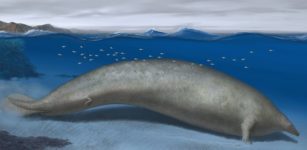 Whale That Lived 40 Million Years Ago Could Be The Heaviest Animal To Have Ever Lived
Paleontology | Aug 8, 2023
Whale That Lived 40 Million Years Ago Could Be The Heaviest Animal To Have Ever Lived
Paleontology | Aug 8, 2023 -
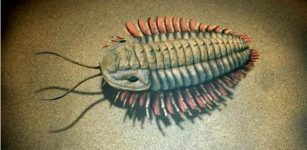 490-Million-Year-Old Trilobites Fossils Reveal Ancient Map
Fossils | Nov 21, 2023
490-Million-Year-Old Trilobites Fossils Reveal Ancient Map
Fossils | Nov 21, 2023 -
 Which Came First: The Reptile Or The Egg?
Evolution | Jun 12, 2023
Which Came First: The Reptile Or The Egg?
Evolution | Jun 12, 2023 -
 170-Million-Year-Old Sea Monster Identified As The Oldest Mega-Predatory Pliosaur
Evolution | Oct 23, 2023
170-Million-Year-Old Sea Monster Identified As The Oldest Mega-Predatory Pliosaur
Evolution | Oct 23, 2023 -
 Evolution Of The Largest of The Large Dinosaurs
Evolution | May 9, 2023
Evolution Of The Largest of The Large Dinosaurs
Evolution | May 9, 2023 -
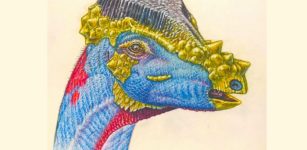 Newly Described Species Of Dome-Headed Dinosaur May Have Sported Bristly Headgear
News | May 24, 2023
Newly Described Species Of Dome-Headed Dinosaur May Have Sported Bristly Headgear
News | May 24, 2023 -
 Fossil Of Prehistoric Saber-Toothed Cat Found In Texas
Fossils | Jun 11, 2024
Fossil Of Prehistoric Saber-Toothed Cat Found In Texas
Fossils | Jun 11, 2024 -
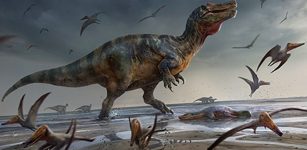 Multiple Species Of Semi-Aquatic Dinosaur May Have Roamed Pre-Historic Britain
Paleontology | Jun 14, 2023
Multiple Species Of Semi-Aquatic Dinosaur May Have Roamed Pre-Historic Britain
Paleontology | Jun 14, 2023 -
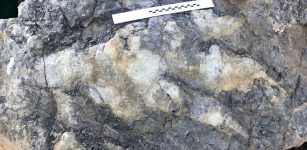 Giant Meat-Eating Dinosaur Footprint Found In Yorkshire Could Be The Largest Ever
Paleontology | Apr 12, 2023
Giant Meat-Eating Dinosaur Footprint Found In Yorkshire Could Be The Largest Ever
Paleontology | Apr 12, 2023 -
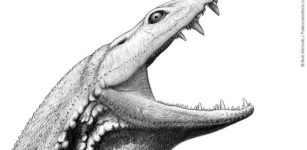 Crushed Scottish Fossils Reconstructed To Reveal Ancient Predator’s Skull
Paleontology | May 5, 2023
Crushed Scottish Fossils Reconstructed To Reveal Ancient Predator’s Skull
Paleontology | May 5, 2023 -
 ‘Giant’ Predator Worms More Than Half A Billion Years Old Discovered In North Greenland
Paleontology | Jan 4, 2024
‘Giant’ Predator Worms More Than Half A Billion Years Old Discovered In North Greenland
Paleontology | Jan 4, 2024

